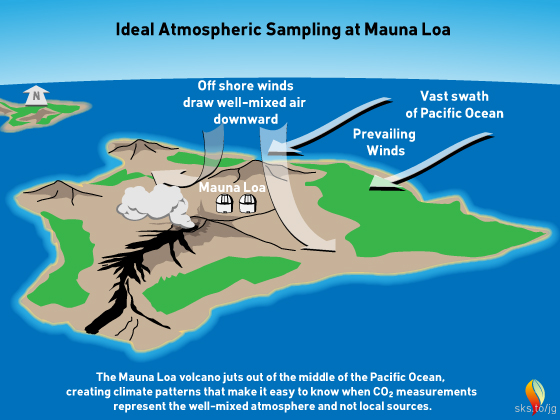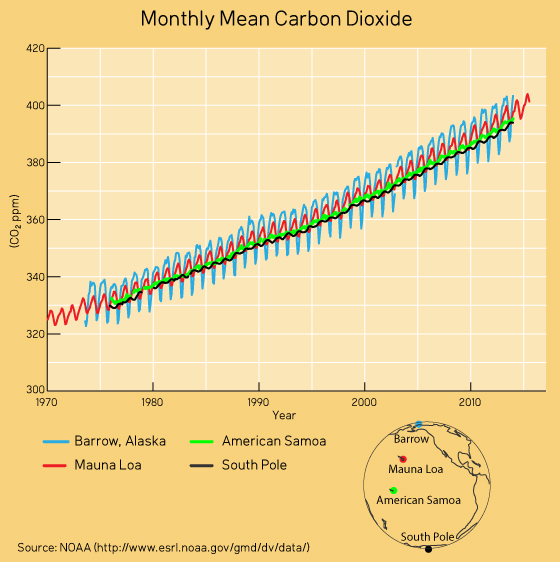Mauna Loa and global network of CO2 measurements
What the science says...
| Select a level... |
 Basic
Basic
|
 Intermediate
Intermediate
|
 Advanced
Advanced
| ||||
|
The measurements of the amount of CO2 made at the Mauna Loa Observatory are accurate and uncontaminated by any emissions from the volcano. The measurements show a steadily increasing tend of CO2 concentrations in the air, a trend that is confirmed by many measurements made elsewhere. |
|||||||
Mauna Loa is a volcano
'Mauna Loa has been producing a readout which supports Manning's predetermined goal by showing steady growth in atmospheric CO2 concentrations since 1959. Just thirty miles from the observatory, Kilauea's Pu`u O`o vent sends 3.3 million metric tons of CO2 into the atmosphere every year. Pu`u O`o sends into "the undisturbed air" near "the remote location" the equivalent to yearly CO2 production from an average city of 660,000 people.' (Andrew Walden)
The observatory near the summit of the Mauna Loa volcano in Hawaii has been recording the amount of carbon dioxide in the air since 1958. This is the longest continuous record of direct measurements of CO2 and it shows a steadily increasing trend from year to year; combined with a saw-tooth effect that is caused by changes in the rate of plant growth through the seasons. This curve is commonly known as the Keeling Curve, named after Charles Keeling, the American scientist who started the project.
Why Mauna Loa? Early attempts to measure CO2 in the USA and Scandinavia found that the readings varied a lot due to the influence of growing plants and the exhaust from motors. Mauna Loa is ideal because it is so remote from big population centres. Also, on tropical islands at night, the prevailing winds blow from the land out to sea, which effect brings clean, well-mixed Central Pacific air from high in the atmosphere to the observatory. This removes any interference coming from the vegetation lower down on the island.
But how about gas from the volcano? It is true that volcanoes blow out CO2 from time to time and that this can interfere with the readings. Most of the time, though, the prevailing winds blow the volcanic gasses away from the observatory. But when the winds do sometimes blow from active vents towards the observatory, the influence from the volcano is obvious on the normally consistent records and any dubious readings can be easily spotted and edited out (Ryan, 1995).
(Illustration updated on 9/5/2015)
Importantly, Mauna Loa is not the only atmospheric measuring station in the world. As the graph from NOAA shows, other stations show the same year-after-year increasing trend. The seasonal saw-tooth varies from place to place, of course, but the background trend remains steadily upwards. The Keeling Curve is one of the best-defined results in climatology and there really are no valid scientific reasons for doubting it.
Further reading: Spencer Weart's The Discovery of Global Warming describes Charles Keeling's research efforts in more detail. Weart also has a separate article on Keeling's struggle to fund his research.
Last updated on 6 September 2015 by Andy Skuce. View Archives































 Arguments
Arguments

































Climate Myth...